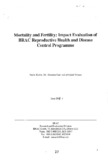Mortality and fertility: impact evaluation of BRAC reproductive health and disease control programme
Citation
Karim, F., Tripura, A., & Gani, M. S. (2001, June). Mortality and fertility: impact evaluation of BRAC reproductive health and disease control programme. Research Reports (2001): Health Studies, Vol - XXX, 27–53.Abstract
This study assessed the impact of BRAC's RHDC programme on fertility and mortality
compared to the baseline status as well as the comparison area. Subsequently, a number
of variables such as total fertility rate (TFR), age-specific fertility rates (ASFR), crude
birth rate (CBR), crude death rate (CDR), infant mortality rate (IMR), child mortality rate
(CMR), under-five mortality rate (USMR) and age-specific death rates (ASDR) were
chosen for analysis. These variables are measurable and widely accepted to reveal the
impact of any reproductive health programme. Moreover, we have baseline data on these
variables for comparison.
In the baseline study (1992) fertility and mortality data were collected from
12,073 households (programme 8,072 and comparison 4,001) representing a total of 261
villages (programme 184 and comparison 77). But, in the follow-up study done in 2000,
103 villages (programme 80 and comparison 23) were revisited. Using the cluster survey
method, data were collected from 8,033 households (programme 4,003 and comparison
4,030) in the follow-up study. Each married woman was asked to provide information on
the number of children she had given birth during the 12 months recall period.
Information on all the live births were collected, such as name, sex, date and place of
birth, age, father's name and occupation, and birth order of the child. Similarly, data on
death that occurred during the last 12 months along with name, sex, month and year of
death, age at death, marital status and causes of death, were also collected.
The study found that the reduction of TFR from the baseline to the follow-up
study was sharper in the programme area than in the comparison (21% versus 13%). The
present TFR for both the areas was identical (programme 2.7 and comparison 2.6/1,000
women). It is to be noted that the benchmark TFR was higher in the programme area than
in the comparison area (3.4 versus 3.0).

